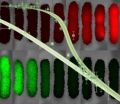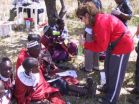(Press-News.org) In biology, scientists typically conduct experiments first, and then develop mathematical or computer models afterward to show how the collected data fit with theory. In his work, Rob Phillips flips that practice on its head. The Caltech biophysicist tackles questions in cellular biology as a physicist would—by first formulating a model that can make predictions and then testing those predictions. Using this strategy, Phillips and his group have recently developed a mathematical model that accounts for the way genes compete with each other for the proteins that regulate their expression.
A paper describing the work appears in the current issue of the journal Cell. The lead authors on the paper are Robert Brewster and Franz Weinert, postdoctoral scholars in Phillips's lab.
"The thing that makes this study really interesting is that we did our calculations before we ever did any experiments," says Phillips, the Fred and Nancy Morris Professor of Biophysics and Biology at Caltech and principal investigator on the study. "Just as it is amazing that we have equations for the orbits of planets around stars, I think it's amazing that we are beginning to be able to write equations that predict the complex behaviors of a living cell."
A number of research teams are interested in modeling gene expression—accurately describing all the processes involved in going from a gene to the protein or other product encoded by that DNA. For simplicity's sake, though, most such models do not take competition into consideration. Instead, they assume that each gene has plenty of whatever it needs in order to be expressed—including the regulatory proteins called transcription factors. However, Phillips points out, there often is not enough transcription factor around to regulate all of the genes in a cell. For one thing, multiple copies of a gene can exist within the same cell. For example, in the case of genes expressed on circular pieces of DNA known as plasmids, it is common to find hundreds of copies in a single cell. In addition, many transcription factors are capable of binding to a variety of different genes. So, as in a game of musical chairs, the genes must compete for a scarce resource—the transcription factors.
Phillips and his colleagues wanted to create a more realistic model by adding in this competition. To do so, they looked at how the level of gene expression varies depending on the amount of transcription factor present in the cell. To limit complexity, they worked with a relatively simple case—a gene in the bacterium E. coli that has just one binding site where a transcription factor can attach. In this case, when the transcription factor binds to the gene, it actually prevents the gene from making its product—it represses expression.
To build their mathematical model, the researchers first considered all the various ways in which the available transcription factor can interact with the copies of this particular gene that are present in the cell, and then developed a statistical theory to represent the situation.
"Imagine that you go into an auditorium, and you know there are a certain number of seats and a certain number of people. There are many different seating arrangements that could accommodate all of those people," Phillips says. "If you wanted to, you could systematically enumerate all of those arrangements and figure out things about the statistics—how often two people will be sitting next to each other if it's purely random, and so on. That's basically what we did with these genes and transcription factors."
Using the resulting model, the researchers were able to make predictions about what would happen if the level of transcription factor and the number of gene copies were independently varied so that the proteins were either in high demand or there were plenty to go around, for example.
With predictions in hand, the researchers next conducted experiments while looking at E. coli cells under a microscope. To begin, they introduced the genes on plasmids into the cells. They needed to track exactly how much transcription factor was present and the rate of gene expression in the presence of that level of transcription factor. Using fluorescent proteins, they were able to follow these changes in the cell over time: the transcription factor lit up red, while the protein expressed by the gene without the transcription factor attached glowed green. Using video fluorescence microscopy and a method, developed in the lab of Caltech biologist Michael Elowitz, for determining the brightness of a single molecule, the researchers were able to count the level of transcription factor present and the rate at which the green protein was produced as the cells grew and divided.
The team found that the experimental data matched the predictions they had made extremely well. "As expected, we find that there are two interesting regimes," says Brewster. "One is that there's just not enough protein to fill the demand. Therefore, all copies of the gene cannot be repressed simultaneously, and some portion will glow green all the time. In that case, there are correlations between the various copies of the genes. They know, in some sense, that the others exist. The second case is that there is a ton of this transcription factor around; in that case, the genes act almost exactly as if the other genes aren't there—there is enough protein to shut off all of the genes simultaneously."
The data fit so well with their model, in fact, that Phillips and his colleagues were able to use plots of the data to predict how many copies of the plasmid would be found in a cell as it grew and multiplied at various points throughout the cell cycle.
"Many times in science you start out trying to understand something, and then you get so good at understanding it that you are able to use it as a tool to measure something else," says Phillips. "Our model has become a tool for measuring the dynamics of how plasmids multiply. And the dynamics of how they multiply isn't what we would have naively expected. That's a little hint that we're pursuing right now."
Overall, he says, "this shows that the assertion that biology is too complicated to be predictive might be overly pessimistic, at least in the context of bacteria."
INFORMATION:
The work described in the paper, "The Transcription Factor Titration Effect Dictates Level of Gene Expression," was supported by the National Institutes of Health and by the Fondation Pierre-Gilles de Gennes. Additional coauthors are Mattias Rydenfelt, a graduate student in physics at Caltech; Hernan Garcia, a former member of Phillips's lab who is now at Princeton University; and Dan Song, a graduate student at Harvard Medical School.
An equation to describe the competition between genes
Caltech researchers develop and verify predictive mathematical model
2014-03-13
ELSE PRESS RELEASES FROM THIS DATE:
Study finds that social ties influence who wins certain Hollywood movie awards
2014-03-13
WASHINGTON, DC, March 13, 2014 — When it comes to Oscars and some other Hollywood movie awards, who your friends are affects whether you win, according to a new study.
"Sociological theory suggests that the process of 'making it' in any field depends not only on individual merit, but also on the kind of audience that makes the judgments," said co-author Paul D. Allison, a sociology professor at the University of Pennsylvania. "Specifically, our study found that peers are more likely to favor award candidates who are highly embedded in the field, whereas critics will not ...
Study proposes new ovarian cancer targets
2014-03-13
PROVIDENCE, R.I. [Brown University] — In the complex genomic and molecular conspiracy that gives rise to ovarian cancer, what if researchers have been missing a whole set of suspects because they've been hiding in plain sight? That's the argument made by Brown University biologists in a new paper that combines evidence from original research and prior studies to raise new suspicions about a set of proteins that assist in regulating gene expression.
Scientists need such new leads in their investigation of ovarian cancer, the most deadly reproductive cancer. Mortality has ...
UCLA study yields more accurate data on thousands of years of climate change
2014-03-13
Using a cutting-edge research technique, UCLA researchers have reconstructed the temperature history of a region that plays a major role in determining climate around the world.
The findings, published online Feb. 27 in the journal Nature Geoscience, will help inform scientists about the processes influencing global warming in the western tropical Pacific Ocean.
The study analyzes how much temperatures have increased in the region near Indonesia, and how ocean temperatures affect nearby tropical glaciers in Papua New Guinea and Borneo. Researchers also evaluated ...
Migration in China: Shifting slightly, but still going strong
2014-03-13
The brain drain of educated workers is still felt most severely in China's central and western provinces, since most knowledge-based industries are generally concentrated in its large coastal cities. However, low-educated migrant workers increasingly find jobs in their home provinces in the central and western regions because of changing economic and government policy. So says Ye Liu and his colleagues of The Chinese University of Hong Kong in Hong Kong and The University of Leeds in the United Kingdom, who carried out a systematic analysis of migration trends in China ...
Mount Sinai scientists discover how Marburg virus grows in cells
2014-03-13
New York, NY – A protein that normally protects cells from environmental stresses has been shown to interact Marburg virus VP24, allowing the deadly Marburg virus to live longer and replicate better, according to a cell culture study led by scientists at the Icahn School of Medicine at Mount Sinai. The investigators say that deciphering the molecular details of how Marburg virus and the host protein interact may help in developing inhibitors of the virus. Results from the study are published online March 13 in the peer-reviewed journal Cell Reports.
Infections with Marburg ...
Commonly used pain relievers have added benefit of fighting bacterial infection
2014-03-13
Some commonly used drugs that combat aches and pains, fever, and inflammation are also thought to have the ability to kill bacteria. New research appearing online on March 13 in the Cell Press journal Chemistry & Biology reveals that these drugs, better known as NSAIDs, act on bacteria in a way that is fundamentally different from current antibiotics. The discovery could open up new strategies for fighting drug-resistant infections and "superbugs."
"We discovered that some anti-inflammatory drugs used in human and veterinary medicine have weak antibiotic activity and ...
Extinct California porpoise had a unique underbite
2014-03-13
Millions of years ago, the coast of California was home to a species of porpoise distinguished from its living relatives by a lower jaw that extended well beyond the upper, according to researchers who report their findings in the Cell Press journal Current Biology on March 13. In other words, the long-lost porpoise had a rather distinct and unusual underbite.
Careful analysis of the fossilized Semirostrum ceruttii skull also shows that the porpoise's pronounced beak included innervated jaws, which the animal likely used to feel for prey along the ocean floor.
"The ...
Humans' ability to digest milk stems from the advent of cattle domestication in Africa
2014-03-13
Most people lose the ability to digest the milk sugar lactose after weaning, but some populations retain high levels of an enzyme called lactase, which allows them to break down lactose in adulthood. In a study published March 13th in the American Journal of Human Genetics, researchers identified genetic factors associated with lactase persistence in African populations and found that this trait became more prevalent in recent history in conjunction with the introduction and spread of cattle domestication in Africa. The findings provide strong evidence that lactase persistence ...
A versatile mouse that can teach us about many diseases and drugs
2014-03-13
Scientists from the UK and Australia have created a mouse that expresses a fluorescing 'biosensor' in every cell of its body, allowing diseased cells and drugs to be tracked and evaluated in real time and in three dimensions.
This biosensor mimics the action of a target molecule, in this case a protein known as 'Rac', which drives cell movement in many types of cancer. Rac behaves like a switch, oscillating on the molecular level between two states – active or inactive.
When Rac is active, the biosensor picks up chemical cues and glows blue. When Rac is inactive the ...
Penn team links Africans' ability to digest milk to spread of cattle raising
2014-03-13
Babies are born with the ability to digest lactose, the sugar found in milk, but most humans lose this ability after infancy because of declining levels of the lactose-digesting enzyme lactase. People who maintain high levels of lactase reap the nutritive benefits of milk, however, offering a potential evolutionary advantage to lactase persistence, or what is commonly known as lactose tolerance.
A new study led by University of Pennsylvania researchers — constituting the largest investigation ever of lactase persistence in geographically diverse populations of Africans ...
LAST 30 PRESS RELEASES:
Penn researchers awarded $25M to conduct trial using smartphones to fight heart disease
PCORI awards funding for new patient-centered healthcare research
Exploring the origins of the universe: 145 low-noise amplifiers complete ALMA telescopes
Empress cicada wings help illuminate molecular structure
Using sound waves to detect helium
Time burden in patients with metastatic breast and ovarian cancer from clinic and home demands
Researchers discover bias in AI models that analyze pathology samples
Scientists ID potential way to prevent brain injuries from triggering Alzheimer's
MASTER 2nd Open Call: Execution period kick-off
Algae for health in food and pharma
Advanced microrobots driven by acoustic and magnetic fields for biomedical applications
Chicago health information leader recognized for raising CPR readiness and blood pressure awareness
The Intimate Animal, a new book from Kinsey Institute Executive Director Dr. Justin Garcia
When blue-collar workers lose union protection, they try self-employment
New video dataset to advance AI for health care
MEA-based graph deviation network for early autism syndrome signatures in human forebrain organoids
New modeling approach sheds light on rare gut disease
Study documents potentially hazardous flame retardants in firefighter gear
Can certain bacteria regulate aging of the immune system and its related alterations?
AI model helps diagnose often undetected heart disease from simple EKG
There are fewer online trolls than people think
Cell membrane fluctuations produce electricity
Jeonbuk National University study shows positive parenting can protect adolescents against self-harm
Surface-engineered ZnO nanocrystals to tackle perfluoroalkyl substance contamination
This new understanding of T cell receptors may improve cancer immunotherapies
A new fossil face sheds light on early migrations of ancient human ancestor
A new immunotherapy approach could work for many types of cancer
A new way to diagnose deadly lung infections and save lives
40 percent of MRI signals do not correspond to actual brain activity
How brain-inspired algorithms could drive down AI energy costs
[Press-News.org] An equation to describe the competition between genesCaltech researchers develop and verify predictive mathematical model





